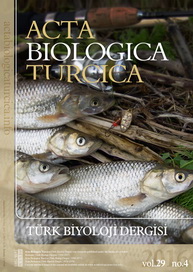Evaluation of body shape variation in species of genus Garra Hamilton, 1822 by geometric morphometry
Abstract
In this study, body shape variation among four species of Garra Hamilton, 1822 distributed in Turkey was investigated using geometric morphometry method. In this context, 570 individuals from 22 populations of G. rufa, G. turcica, G. orontesi and G. variabilis were analysed. The specimens used in the study were collected during the field studies carried out between 2014 and 2022. The specimens were photographed from the left side view and the data were digitised by assigning 14 landmarks to the areas important for species identification. After generalised procrustes analysis (GPA), Principal Component Analysis (PCA) and Discriminant Function Analysis (DFA) and clustering analysis were used to determine the value of intraspecific similarities and differences. According to the data obtained as a result of the study; G. turcica and G. variabilis were the species with the highest intraspecific variation, while G. rufa was the species with the lowest intraspecific variation. For the species evaluated, the most variation was observed in the tip of the snout, eye position, caudal peduncle height, body height and the beginning of the operculum. It was observed that the range of phenotypic plasticity of the species was wide, this variation decreased in the intersection regions of the populations, and the level of plasticity increased in geographically distant populations.
Keywords
Full Text:
PDFRefbacks
- There are currently no refbacks.

